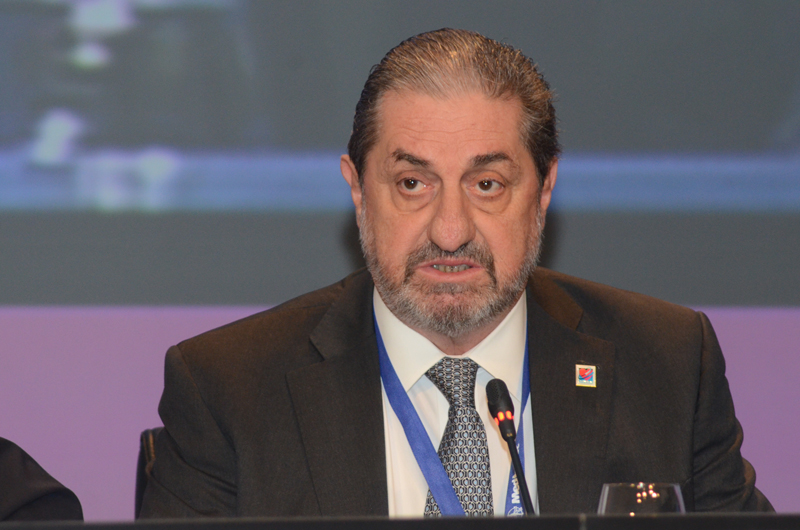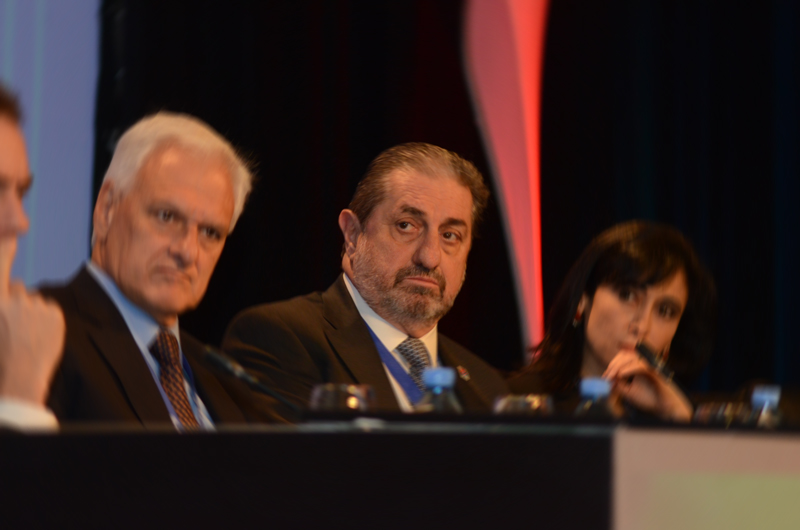He grew up in the 40s, surrounded by cap screws, dental crowns and damp from the Paraná River. His father, mother and two brothers, were dentists. Years later, his daughter and niece would also become dentists. But since his early years, Hugo Londero had known he would become a physician. He was certain his greatest passion was not for teeth and gums, but for “someplace else where pain starts: the heart”.
Perhaps his father had some influence, since he never encouraged him to become a dentist: “He was not happy with his career choice; he used to say back then, 50 or 60 years ago, odontology was monotonous and boring”.
When the time came, Londero moved to the city of Córdoba to attend medical school and, from then on, he adopted “La Docta” as his second home. It was there where he met Betty, the cordobesa he started a family with: “What’s happened to many, happened to me too. I started dating a cordobesa, I married her and I turned cordobés”, Londero laughs. “This is how it goes: you start drinking fernet and coke, dancing cuarteto and… these are such strong things”.
With Betty they had four children. One of them, also called Hugo, chose the same path and, at present, he is a fellow at the Hemodynamics and Interventional Cardiology Service at Allende Sanatorium, in Córdoba. “Many physicians discourage their kids from going to med school. I totally disagree. I would have loved that all my children had become physicians. As hard as it may be, if you like it, it is highly rewarding”.
How did interventional cardiology come into your life?
“Back then, I had no idea interventional cardiology would become my field, because it started after I went to med school. I graduated in 1971 and the very first stent was implanted in 1977. My fellowship in hemodynamics was all about diagnostic procedures. Between 1972 and 1977, I trained in hemodynamics at Güemes, Sanatorium in Buenos Aires, with Doctors [Luis] De La Fuente and [René] Favaloro, who had an outstanding team. After that, I came back to Córdoba, where I took up the hemodynamics service until interventional cardiology arrived. Then, I went to Sao Paulo to learn from Dr. Eduardo Sousa how to perform a coronary angioplasty. Interventional cardiology was the happy ending of hemodynamics.”
Why?
Because it was game-changing. Suddenly, we went from diagnosing to healing. This was a major leap because, all of a sudden, we had the chance to cure serious conditions using non-invasive techniques. This not only changed the idea families and patients had of physicians, but also physicians’ personalities.
You mentioned before Dr. Luis de la Fuente. Together with him, you created a very specific catheter for the carotid artery. How did that happen?
(He laughs). We simply needed it. At the time, doctors Favaloro and De La Fuente were promoting a different approach to atherosclerosis: not as a disease of the heart but as a disease of the arteries. This is why we conducted so many angiographies, but the catheters we used to look into neck vessels had not been designed for that, hence the challenge. We had to position the catheter, which resisted… it was very tricky. To solve this, we started discussing how to design a specific catheter for this procedure, with radiologist Aníbal Marraco, an all-time friend. That is how we got to design this catheter that, to this day, after a few changes, we are still using to conduct angiography procedures on neck vessels.
This would determine your career path since, after that, you specialized, among other things, in carotid angioplasty.
That’s right. That’s how it is when you start, you have no idea how important it might become. I remember once when, in the early 90s, Dr. Gerald Dorros, an interventionist from USA, came visit, and asked me: “You are Dr. Londero? Have you got anything to do with the Londero that published an article on…?”, “Yes, that would be me” I replied. It turns out he remembered my article because it was relevant to his research, about 10 years after it had been published! A philosopher from La Plata, unfortunately gone already, wisely used to say: “It is men who get weary, not men’s ideas. Ideas flow”. Back then, one man makes a catheter and down comes another who modifies it, to make something more specific. Ideas do not belong to one single person. Perhaps, this was so 200 years ago, but today, it’s all about team work.
Is that why you decided not to patent this catheter?
No, we had no idea we could patent the catheter (laughing). If we had known, we might have made a great deal of money with Luis de la Fuente, but we didn’t even think of it. We simply developed something we needed badly.
Which do you reckon are the most promising innovations of these last years, in terms of devices and procedures, in interventional cardiology?
I think the technology behind structural heart disease. At present, transcatheter heart valve implantation is drawing international attention. Initially, heart valve implantation was limited to patients with surgery counterindication. Today, patients with normal surgical risk receive heart valves with comparable outcomes. TAVI technology is currently the fastest evolving one.
You were the Chief of Hemodynamics and Percutaneous Coronary Intervention at the Favaloro Foundation up to December 28, 2000, a tragic year for the foundation. How do you remember that time and why did you decide to retire?
It was a very hard time. I had worked at the Foundation for 8 years, since the institute opened until a few months after Favaloro passed away. During all that time, I lived in Córdoba and commuted to Buenos Aires 3 days a week. I had taken this job as something temporary. Favaloro proposed that I developed the department of Interventional Cardiology at the foundation. I might have accepted out of idealism, or to contribute to the development of something I believed was extremely important for my country. Unfortunately, after Favaloro left us, things became a little unsettling. There were several ideas on how to carry on with the institute and I did not entirely agree with how things were unravelling. That is why I stopped going. And, above all, because with Favaloro gone, the most important reason for me to work there, was also gone. Fortunately, the institute carried on with his legacy. Argentina should be proud of it.
SOLACI: The struggle to maintain cohesion among Latin American interventional cardiologists
The Brazilian educator Paulo Freire would say: “To educate is to love and, as such, it is an act of courage”. In addition, Dr. Londero regards education as an obligation. “Education is mandatory for experienced and accomplished people. We have must pass on what we have learnt to the biggest number of colleagues possible. The development of interventional cardiology cannot be an individual effort, with specialists working by themselves in a cath lab. Game-changing ideas are a result of team effort”, Londero claims.
With this idea, in the 80s, together with Dr. Marcelo Ruda Vega, they created the specialization on Hemodynamics, General Angiography and Interventional Cardiology at the University of Buenos Aires and The Argentinian School of Interventional Cardiologists (CACI). “After a while we saw that this wasn’t enough. It was best that those who had been trained could keep up to date. This is how we came to create the refresher course”.
The refresher course is blended, renewed year after year, and it is the only way interventional cardiologists are able to continue their training. The CACI also involves centers across Argentina for physicians to practice. Lectures are delivered in Buenos Aires twice a month.
Eventually, lectures will be delivered online, is that right?
This is why ProEducar was created together with SOLACI. To implement a refresher course for Latin Americans that required attendance, was impossible. At the beginning, one of our most active collaborators was Dr. José Gabay. At present, we count on Dr. [Leandro] Lasave. The aim of ProEducar is to facilitate the tools to advance knowledge for all interventional cardiologists across Latin America, using the Internet.
In addition to contributing with SOLACI in education, you were their first president, between 1994 and 1996. Please, tell us about it.
As usual, at the beginning it was not easy to reach an agreement across Latin America. I remember an occasion, at one meeting in the US, I succeeded to organize a dinner party for SOLACI’s friends ─ 30 or 40 at the time ─ to share and celebrate. Someone from the industry supported the idea, rented a room and ordered a buffet, American style, with flowers, plenty of food… something quite important. When the time came, only a Frenchman, working for an American Company, a coworker of his, and I showed up. No one else came (laughs). Well, those were the starts. Getting together can be hard.
What were the greatest challenges of your administration?
One of the greatest challenges was the first SOLACI meeting, which took place in Sao Paulo. It was organized by Dr. Eduardo Sousa and was a real achievement because people from all over Latin America came. From the start, we strive to maintain united, to achieve structure, a program, to keep focused and transcend individuality. There will always be complains and disagreement, but I think SOLACI has grown beyond measure. We can feel proud of our society.
By Laura Spiner.







